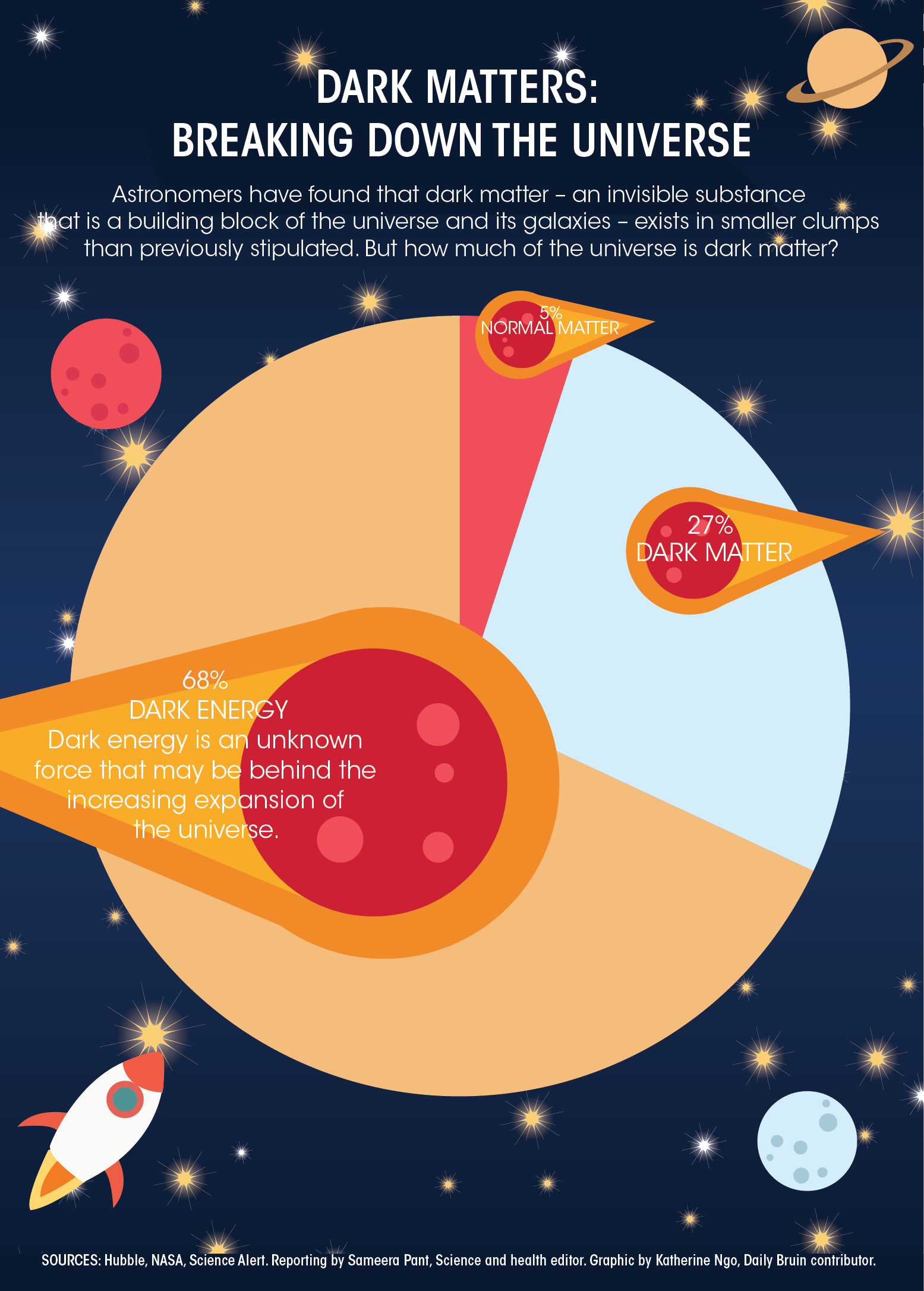Researchers find evidence of small dark matter halos with new gravity-based method

(Katherine Ngo/Daily Bruin)

By Shruti Iyer
Jan. 29, 2020 12:12 a.m.
UCLA researchers have found a new way to detect dark matter structures in the universe.
Researchers found proof of small clusters of dark matter using a new gravity-based method to calculate the rate at which the universe is expanding.
The group then published two papers: one on its evidence for dark matter, and one on the new Hubble constant that describes the universe’s expansion rate.
Modeling the evolution of the universe based only on gravity doesn’t match what scientists observe, said Anna Nierenberg, the principal investigator for the project and a researcher at the NASA Jet Propulsion Laboratory.
However, if researchers assume around 85% of the total mass in the universe is some kind of noninteracting particle, then the models correctly evolve to the universe that is observed today, Nierenberg said.
This particle is dark matter, and researchers don’t really know a lot about it, she said.
“We know how much (dark matter) we think there should be, we have limits on how much it can interact with light, but other than that, we don’t really know a lot about it,” Nierenberg said. “So it’s one of the biggest questions in modern physics.”
The team’s observations indicate the presence of invisible mass, without which the formation of the universe would be impossible, said Simon Birrer, a postdoctoral fellow at Stanford University.
Dark matter dominates the mass of the universe, said Daniel Gilman, a UCLA graduate student in physics and astronomy and the lead author of the paper on dark matter.
Although researchers are uncertain what it is, they think it might be a particle, Birrer said.
Particles tend to collect in gravitationally bound massive structures of dark matter called halos, Gilman said. Scientists look at these structures to attempt to identify the nature of dark matter.
Dark matter is difficult to study because it doesn’t interact with anything through any force other than gravity, Gilman said. Therefore, gravity is the only way to study dark matter.
“So gravity is the only portal we have to study dark matter, and gravitational lensing, which is the reflection of light by gravitational fields, becomes a direct way to look for these halos and distributions of dark matter in the universe,” Gilman said.
Gilman said the distribution and the size of these halos depend on the particle nature of dark matter. Generally, bigger halos of dark matter have galaxies and stars in them, so it becomes easier to estimate how massive the halo is by how big the galaxy is.
“If you can find smaller ones, if you can go down and look for smaller and smaller halos, you can learn more and more about the nature of (dark) matter,” Gilman said.
Once you move to smaller mass structures, Gilman said, the halos stop containing stars in them, making them completely invisible, and gravitational lensing becomes the only way to detect them.
Gravitational lensing of light is a phenomenon that occurs when light passing by a mass is bent by the force of the mass’s gravity, said Anowar Shajib, a graduate student in astronomy and astrophysics at UCLA and an author on the Hubble constant paper.
Gravitational lensing was also used to independently measure the Hubble constant, which was different from two previously accepted methods that yielded conflicting results, Shajib said.
The Hubble constant is a number that can be used to find out how fast the universe is expanding.
Scientists can use the gravitational lensing phenomenon to measure distance by observing the light emitted by a galaxy directly behind another galaxy, Shajib said. Light from the back galaxy comes at an angle, bends and then reaches us, so multiple images of the same galaxy are observed, Shajib added.
“For example, in the mirror, the things aren’t really there, but because the light is getting reflected on the mirror surface, we think something is there on the other side of the mirror, … (or) like when light goes through water or glass, we see things moving a little bit,” Shajib said. “That is just because light is getting deflected.”
This method, Shajib said, provided a unique way to measure distances, which they could use to calculate a new value for the Hubble constant.
Nierenberg, a UCLA alumna, said they used these images resulting from gravitational lensing to look at the individual brightness of each image. She said the relative brightness of these images depends on the distribution of mass along the path the light traveled.
The relative brightness of these images was slightly unexpected, Nierenberg said. They then used the images to predict how much mass had been present in the light’s path before it reached Earth, she said. This was how they detected the small dark matter halos.
Gilman said this detection was interesting because some models of dark matter don’t include small halos.
“If you find these small halos, you can say that these classes of models that predict that they don’t exist are wrong, and so it teaches you something very general about what the nature of dark matter is,” Gilman said.
There are many potential candidates for what these dark matter particles are, and there are many possible theories and models for how they interact with the universe, Gilman said.
“The space of theories is gigantic, because we have no idea,” Gilman said. “Through methods like gravitational lensing and stuff like that, we can rule out classes of models, not certain particle candidates. … We’re at the stage now where we’re trying to rule out chunks of models rather than individual potential candidates.”

